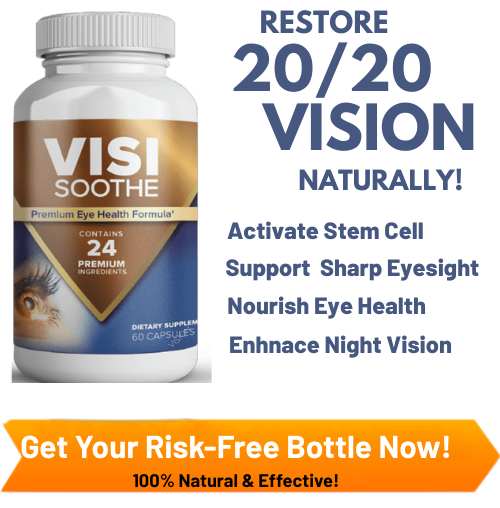Are you tired of blurry vision and wondering how to improve your eyesight without glasses?
Many people believe that once your vision declines, glasses or contacts are the only solution. However, it is possible to restore eyesight naturally through a series of proven techniques. The journey to clearer vision is a holistic one, combining targeted exercises, proper nutrition, and healthy lifestyle habits.
This comprehensive guide will walk you through proven strategies to correct your vision without glasses. We'll explore effective eye exercises, essential nutrients for eye health, and practical daily habits. We will also address the truth behind popular vision "hacks" and "tricks" to give you a realistic and science-backed path toward achieving your goal.
Can Eyesight Really Be Restored Naturally?
Before we dive in, let's address the most important question: Can eyesight be restored? For many people, yes. While natural methods may not cure all vision problems (like severe nearsightedness or astigmatism), they can significantly improve visual acuity, reduce eye strain, and strengthen the eye muscles.
The key is consistency and understanding that results take time. By committing to the methods below, you are investing in the long-term health of your eyes and taking active steps to get your 20/20 vision back.

6 Powerful Eye Exercises to Improve Vision
Just as we exercise our bodies, we can train our eye muscles to improve focus, flexibility, and overall performance. Incorporating these exercises into your daily routine is a cornerstone of improving eyesight without glasses.

Near and Far Focus
This classic exercise improves your eyes' flexibility and adaptability.- How to do it: Hold your thumb about 10 inches from your face and focus on it for 15 seconds. Then, shift your gaze to an object 20 feet away and focus on it for 15 seconds. Repeat this cycle 5 times.
- How to do it: Hold your thumb about 10 inches from your face and focus on it for 15 seconds. Then, shift your gaze to an object 20 feet away and focus on it for 15 seconds. Repeat this cycle 5 times.
Pencil Push-ups
This exercise is excellent for training your eyes to converge, which is vital for reading and up-close tasks.- How to do it: Hold a pencil at arm's length, pointing away from you. Slowly bring the pencil closer to the bridge of your nose, maintaining a single, focused image of it for as long as you can. As soon as it doubles, pull it away. Repeat 10-15 times.
- How to do it: Hold a pencil at arm's length, pointing away from you. Slowly bring the pencil closer to the bridge of your nose, maintaining a single, focused image of it for as long as you can. As soon as it doubles, pull it away. Repeat 10-15 times.
Figure Eight
This improves the agility and smooth tracking motion of your eyes.- How to do it: Imagine a large figure eight on the floor about 10 feet in front of you. Without moving your head, trace the shape of the figure eight with just your eyes. Continue for 30 seconds, then switch directions.
- How to do it: Imagine a large figure eight on the floor about 10 feet in front of you. Without moving your head, trace the shape of the figure eight with just your eyes. Continue for 30 seconds, then switch directions.
Saccades (Rapid Shifting)
Saccades are the quick, simultaneous movements of both eyes in the same direction. Training them improves your ability to shift focus rapidly.- How to do it: Sit facing a wall with two objects (e.g., sticky notes) placed horizontally about a foot apart. Without moving your head, rapidly shift your gaze from one object to the other. Do this for 30-60 seconds.
- How to do it: Sit facing a wall with two objects (e.g., sticky notes) placed horizontally about a foot apart. Without moving your head, rapidly shift your gaze from one object to the other. Do this for 30-60 seconds.
Palming
This is a relaxation technique designed to soothe tired eyes and relieve strain after screen time or intense focus.- How to do it: Rub your hands together to warm them up. Gently close your eyes and cover them with your cupped palms, being careful not to apply pressure to the eyeballs. Breathe deeply and relax for 1-2 minutes.
- How to do it: Rub your hands together to warm them up. Gently close your eyes and cover them with your cupped palms, being careful not to apply pressure to the eyeballs. Breathe deeply and relax for 1-2 minutes.
Intentional Blinking
We often forget to blink enough, especially when staring at screens, leading to dry, tired eyes.- How to do it: Every 20 minutes, consciously blink 10 to 15 times very slowly, like a camera shutter opening and closing. This re-lubricates the eye surface and reduces dryness and strain.
The Role of Diet: Foods to Reclaim Your Vision
You can't exercise your way out of a bad diet, and the same is true for your eyes. Providing your body with the right nutrients is essential to repair and maintain healthy eye tissue.
- Foods Rich in Vitamin A: Carrots, sweet potatoes, and leafy greens like spinach and kale are packed with Beta-carotene, which the body converts to Vitamin A—a crucial component of the rhodopsin protein that helps you see in low light. This protein is especially vital for adapting to darkness, a topic we explore fully in our guide to improving your night vision naturally.
- Foods Rich in Lutein and Zeaxanthin: Find these powerful antioxidants in brightly colored fruits and vegetables like bell peppers, corn, and broccoli, as well as egg yolks. They act like an internal sunblock, protecting the macula from damaging blue light.
- Foods Rich in Omega-3 Fatty Acids: Fatty fish like salmon, mackerel, and trout are essential for maintaining retinal health and preventing dry eyes.
- Foods Rich in Vitamin C: Oranges, strawberries, and bell peppers are loaded with Vitamin C, an antioxidant that has been shown to lower the risk of developing cataracts.

Vitamins and Supplements to Restore 20/20 Vision
When searching for ways to restore eyesight naturally, you'll encounter many claims about instant fixes. Let's separate fact from fiction.

- The "Vision Clarity Ice Hack": This trend involves putting ice or cold water on the eyes. Does it work? Temporarily, it can cause blood vessels to constrict, which might reduce puffiness and create a momentary sensation of clarity. However, it does nothing to address the root causes of poor vision like refractive errors or eye health. It is not a long-term solution to restore 20/20 vision.
- The "6-Second Trick" or "Odd Trick to Restore Vision": These phrases are often used in marketing to promote specific eye exercises or supplements. They prey on the desire for a quick fix. The reality? There is no single 6-second trick that can permanently restore your vision. True improvement comes from the consistent practice of the exercises and lifestyle changes outlined in this guide.
The takeaway: Be wary of anything promising instant results. True, lasting vision improvement is a marathon, not a sprint
Lifestyle Habits for Lasting Vision Improvement
- Manage Screen Time with the 20-20-20 Rule: This is one of the most effective habits you can adopt. Every 20 minutes of screen time, take a 20-second break to look at something 20 feet away. This simple rule is incredibly effective at preventing digital eye strain.
- Ensure Proper Lighting: Avoid reading or working in dim light, which forces your eyes to strain. At the same time, reduce glare from screens and bright overhead lights.
- Prioritize Sleep: Your eyes repair and rejuvenate themselves while you sleep. Aim for 7-9 hours of quality sleep per night to allow this process to happen.
- Stay Hydrated: Dehydration can lead to dry, strained eyes. Drink plenty of water throughout the day.
For moments when you experience immediate eye fatigue and need quick relief, we have a guide with several practical techniques to help you see clearer without your glasses

Conclusion: Your Path to Clearer Vision Starts Now
The journey to get your 20/20 vision back is an empowering one. By rejecting quick fixes and embracing a holistic approach, you can take control of your eye health. Remember the keys to success:
- Consistency: Perform your eye exercises daily.
- Nourishment: Fuel your eyes with a diet rich in essential nutrients.
- Healthy Habits: Manage screen time, prioritize sleep, and protect your eyes from strain.
By following the proven techniques in this guide, you are not just working towards better eyesight—you are investing in a brighter, clearer future where you can improve your vision without glasses and see the world in all its vibrant detail.
FAQs
The most effective remedies are a combination of targeted eye exercises (like Near-Far Focus and Palming), a diet rich in antioxidants like Lutein and Zeaxanthin, and healthy lifestyle habits like following the 20-20-20 rule.
Results vary by individual. Some people report reduced eye strain in a few weeks. More significant improvements in visual acuity often take several months of consistent, daily practice. Patience is key.
Scientific References:
- Effect of dietary supplementation with lutein and zeaxanthin on age-related macular degeneration progression: the AREDS2 report: https://www.ncbi.nlm.nih.gov/pmc/articles/PMC4362027/
- The Role of Omega-3 Fatty Acids in Eye Health: https://www.ncbi.nlm.nih.gov/pmc/articles/PMC5427405/
- Effect of stress on vision: https://www.ncbi.nlm.nih.gov/pmc/articles/PMC5001662/
Disclaimer: The information presented in this blog post is intended for informational purposes only and should not be considered medical advice. While we strive to provide accurate and up-to-date information, it is not a substitute for professional medical guidance. Always consult with a qualified healthcare professional before making any decisions related to your health or treatment.
We strongly encourage you to seek the advice of a physician or other qualified healthcare provider with any questions you may have regarding a medical condition or treatment. Never disregard professional medical advice or delay seeking treatment because of something you have read in this blog post.
You Might Also Like



1 thought on “How to Get 20/20 Vision Back Naturally: The Complete Guide”